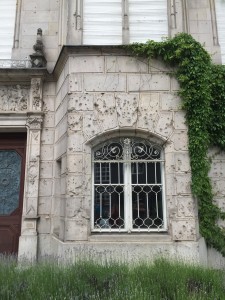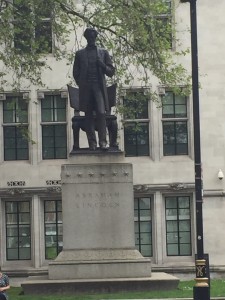Berlin was the most interesting city we visited because it is heavily shaped by the effects of the war, more so than London or Paris. Despite World War II having ended over seventy years ago, remnants Berlin’s past as the capital of Nazi Germany are still present throughout the city. My preconceived ideas about Berlin were that it is a modern city with little remains from the Nazi era. After visiting Berlin, I realized it was both a modern city with remnants from its Nazi past openly throughout the city.
It seemed as though on every street corner you could find a building or monument marked off to commemorate victims of the Nazi régime. For instance, outside our hotel there are stone markers on the sidewalk to commemorate the Jews who lived at that address and were deported. On the Berlin skyline you can see the building of the chemical company BASF – formerly known as IG Farben – who made the Zyklon B for the Nazi gas chambers. Or even just the random building covered in bullet holes from the war remains as a constant reminder of Germany’s past.
The Bundestag – German Parliament – is a great example how the German people acknowledged their Nazi past but are looking forward towards the future. The Bundestag was built in 1995 after the reunification of Germany and is proud monument for Germans as it represents their democratic ideals. The design of the German parliament is very modern inside and made of all glass so that the people can have a transparent democracy and literally watch parliament in session. The structure of the building is the original Reichstag building which has some association with the Nazis, although the Nazis never used it during their reign. There was a major battle for the Reichstag and when the Soviet soldiers captured it they drew graffiti on the inner walls. The graffiti can still be seen today and is a reminder of their past inside parliament. It is almost as if they gutted out the Reichstag building, which represented the old Germany, and built their new democracy from within. The idea of what the new Bundestag represents was important for the woman who gave us a tour of the Bundestag as she told us her grandfather was a member of parliament and ousted when the Nazis came to power.
In the end, Germany is a country that acknowledges the past that is present throughout the city, but looks towards the future. It was really amazing to see how even though the war ended, it really would have been impossible to totally de-Nazify all the memories of the war throughout the city. The new Bundestag acts as the piece of Germany that is looking towards the future as it is built within the remains of the past.












